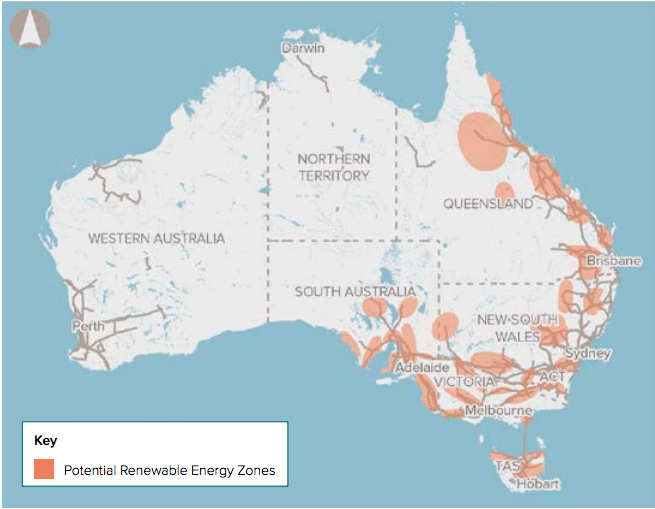Infrastructure Australia has added 44 new projects to its annual Infrastructure Priority List, which guides governments’ investment decisions, listing the expansion of Renewable Energy Zones, hydrogen export infrastructure, EV fast-charging stations and expanding the role for renewable energy in the National Electricity Market as among the nation’s highest priorities.
According to Infrastructure Australia’s Chair, Julieanne Alroe, the list “provides a $59 billion pipeline of investments ready for delivery and nationally significant priorities for Australia’s governments to progress in the near, medium and longer term.”
Of the projects added to the list this year, many relate to transitioning Australia to a low-carbon future. “Investing in new sources of energy is a priority for the nation,” Alroe said in the report’s foreword. “We are committed to providing timely, transparent and evidence-based investment advice for governments at all levels.”
NEM investment
Infrastructure Australia is proposing distributed batteries, large-scale battery energy storage systems and utility-scale pumped hydro to support the National Energy Market’s (NEM) growing renewable energy generation and phase out of coal-fired generators.
“It is likely that a diverse mix of technologies will be required to support the NEM,” the report notes.
It wants to see these changes rollout in the next five to 15 years.
Expanding Renewable Energy Zones
The expansion of Australia’s Renewable Energy Zones (REZ), either by enlarging existing zones or starting new ones, was deemed by the body to be on the High Priority list nationally, with Infrastructure Australia listing a timeframe of between now and 15 years for the government to get cracking.
It suggests the infrastructure within these REZs could include new large-scale wind, solar and hydro, saying co-locating investments is key to reducing overall investment costs.
Enabling infrastructure for hydrogen exports
Echoing broadly held hopes that Australia will become a world-leading green hydrogen exporter, the infrastructure advisor wants to either see upgrades or new infrastructure for electricity and gas networks, water supply networks, refuelling stations, roads, rail and ports. It hopes this will ultimately put Australia’s ducks in a row when green hydrogen production begins here in earnest.
National highway electric vehicle fast charging
Over the next five years, the body is calling for the development of a network of fast-charging EV stations near national highways. It also wants to see policies and regulation developed to support charging technology adoption. It notes complementary investment in network infrastructure may be required to ensure Australia’s notoriously rickety grids can keep up with demand.
“By 2040, electric vehicles (EVs) are projected to account for 70% to 100% of new vehicle sales and at least 30% of the vehicle fleet in Australia. According to the Electric Vehicle Council, more than 19,500 EVs have been sold in Australia since 2011. In 2019, sales increased by 200%, with over 6,700 EVs sold,” the report noted.
Northern Territory large-scale solar generation
Sun Cable’s ambitious 13 GW Australia-ASEAN Power Link, which would be the world’s biggest solar farm, continues to shine bright, with the Australian government including the mega-project on its Priority Initiative List.
“The Northern Territory has a comparative advantage in producing renewable energy, due to its vast land mass, low population density, solar resource and proximity to energy-intense markets in the Indo-Pacific region,” the report noted.
It is proposing a large-scale solar generation and storage project, coupled with appropriate transmission infrastructure, to service domestic and potentially overseas markets – noting that such an undertaking is contingent on market testing.
The proposed timeline for the project is in the next five to ten years.
Northern Territory remote community power generation program
Following in the footsteps of Western Australia’s stand-alone power system (SAPS or SPS) rollout, the group is proposing similar steps for remote towns in the NT. Additionally, the body is advocating Western Australia continue its investment in off-grid systems for remote communities, noting the South West Interconnected System, which powers the state, is in need for transformation.
Pilbara port capacity
Given the boom in demand for lithium, Infrastructure Australia is calling for the port in West Australia’s Pilbara region to be expanded.
“Growing general cargo demand will strain capacity at existing Pilbara ports, such as the ports of Port Hedland and Dampier.
“This growth is driven by the development of several spodumene (lithium) projects in Western Australia’s Pilbara region, responding to increasing demand for renewable energy, lithium and other metals from the consumer electronics, electric vehicles and energy storage industries,” the report noted.
This content is protected by copyright and may not be reused. If you want to cooperate with us and would like to reuse some of our content, please contact: editors@pv-magazine.com.









By submitting this form you agree to pv magazine using your data for the purposes of publishing your comment.
Your personal data will only be disclosed or otherwise transmitted to third parties for the purposes of spam filtering or if this is necessary for technical maintenance of the website. Any other transfer to third parties will not take place unless this is justified on the basis of applicable data protection regulations or if pv magazine is legally obliged to do so.
You may revoke this consent at any time with effect for the future, in which case your personal data will be deleted immediately. Otherwise, your data will be deleted if pv magazine has processed your request or the purpose of data storage is fulfilled.
Further information on data privacy can be found in our Data Protection Policy.